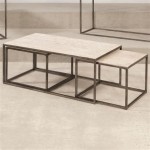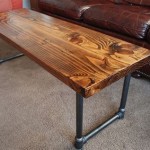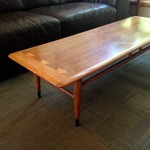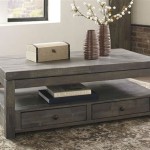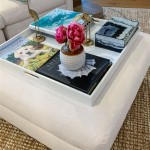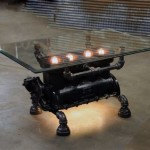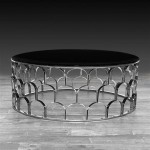Coffee Table Design Ideas: Functionality Meets Aesthetics
The coffee table, often situated at the heart of the living room, serves as more than just a surface to place drinks and magazines. It's a focal point, a statement piece, and a functional element that contributes significantly to the overall design and ambiance of the space. Selecting the right coffee table requires careful consideration of various factors, including size, shape, material, style, and intended use. The following article explores various coffee table design ideas, focusing on how to harmonize these elements to create a space that is both visually appealing and functionally efficient.
The ideal coffee table should complement the existing furniture and reflect the homeowner's personal style. It needs to be appropriately sized for the space, ensuring comfortable circulation around it. Furthermore, the material should be durable and easy to maintain, while the design should enhance the room's overall aesthetic. This detailed examination aims to provide inspiration and guidance for selecting a coffee table that seamlessly integrates into any living room design.
Choosing the Right Shape and Size
Shape and size are paramount considerations when selecting a coffee table. The dimensions should be proportionate to the sofa and the overall room size. A coffee table that is too large can overwhelm the space, making it feel cramped. Conversely, a table that is too small may appear insignificant and fail to provide adequate surface area. As a general guideline, the coffee table should be approximately two-thirds the length of the sofa. This proportion creates a balanced and visually appealing arrangement.
The height of the coffee table is another critical factor. Ideally, it should be the same height as the sofa cushions or slightly lower. This height ensures easy access for placing drinks, books, or decorative items. A coffee table that is significantly higher than the sofa can be awkward to use and detract from the room's visual harmony.
The shape of the coffee table should also complement the room's layout and style. Rectangular coffee tables are a classic choice, well-suited for longer sofas and rectangular living rooms. Square coffee tables work well in smaller spaces or with sectional sofas, providing a sense of balance and symmetry. Round or oval coffee tables are excellent for softening the angles of a room and promoting a more conversational arrangement. They are particularly suitable for homes with young children, as the rounded edges minimize the risk of bumps and bruises.
Consider the accessibility of the coffee table. Ensure adequate space around the table for comfortable movement. Typically, a minimum of 18 inches is recommended between the coffee table and the sofa or other furniture. This spacing allows for easy passage and prevents the feeling of being cramped.
Materials and Styles: Matching Functionality with Aesthetics
The material of the coffee table profoundly impacts its appearance, durability, and maintenance requirements. The choice of material should align with the overall style of the room and the homeowner's personal preferences. Wood is a popular choice, offering warmth, versatility, and a classic aesthetic. Different wood types, such as oak, walnut, and maple, offer varying grains and colors, allowing for seamless integration into diverse design schemes. A solid wood coffee table is sturdy and can withstand wear and tear. Treated carefully, a wooden coffee table can last for decades.
Glass coffee tables offer a sleek and modern look, creating an illusion of space and lightness. They are particularly well-suited for smaller living rooms, as they do not visually weigh down the area. Glass, however, can be prone to scratches and requires frequent cleaning to maintain its pristine appearance. A glass coffee table might be more appropriate for adults than for households with small children because of its fragility.
Metal coffee tables provide a contemporary and industrial aesthetic. They are durable, easy to clean, and can be paired with various materials, such as wood or glass, to create unique and stylish designs. Metal coffee tables are available in a range of finishes, from polished chrome to matte black, allowing for customization to suit different interior styles. Metal typically requires minimal maintenance, ensuring its longevity. Some metals might require periodic coating to prevent rust.
Stone coffee tables, such as those made from marble or granite, exude elegance and sophistication. They are incredibly durable and resistant to heat and scratches. However, stone coffee tables can be heavy and expensive. They are best suited for larger living rooms where their substantial presence can be fully appreciated. Stone is heavy and requires structural support. It is a material appropriate for a permanent living space.
Upholstered coffee tables or ottomans offer a comfortable and versatile option. They can serve as a footrest, extra seating, or a surface for placing trays. Upholstered coffee tables are available in a variety of fabrics and colors, allowing for personalization to match the room's decor. However, upholstered surfaces can be more difficult to clean than other materials and may require professional cleaning.
The style of the coffee table should complement the overall design aesthetic of the living room. A modern living room might benefit from a minimalist coffee table with clean lines and a neutral color palette. A traditional living room might call for a more ornate coffee table with intricate details and a rich wood finish. An eclectic living room offers the opportunity to experiment with unique and unconventional coffee table designs.
Functionality: Storage and Multi-Purpose Designs
Functionality is a crucial aspect of coffee table design. The coffee table should not only be aesthetically pleasing but also serve a practical purpose. Many coffee tables incorporate storage features to help keep the living room organized and clutter-free. Storage options can include drawers, shelves, or hidden compartments.
Coffee tables with drawers are ideal for storing remote controls, magazines, or other small items that tend to accumulate in the living room. Drawers keep these items out of sight, maintaining a clean and organized appearance. The pull-out drawers are convenient for frequent use. Drawers must be designed for smooth operation. They should be made of sturdy materials to withstand heavy use.
Coffee tables with shelves provide open storage for displaying books, decorative objects, or plants. Shelves can also be used to store baskets or bins, further enhancing the organization of the space. Open shelving allows for easy access to frequently used items. It also provides an opportunity to showcase personal style and interests.
Lift-top coffee tables offer a versatile solution for small spaces or multi-functional living rooms. The top of the table can be lifted to create a higher surface for dining, working, or playing games. When not in use, the top can be lowered to its original position, transforming the table back into a standard coffee table. The lift-top mechanism should be sturdy and easy to operate. The table should also provide ample storage space beneath the lift-top surface.
Nesting coffee tables offer another space-saving solution. These tables consist of two or more smaller tables that can be nested together when not in use. When needed, the smaller tables can be pulled out and used as side tables or extra surface area. Nesting tables are particularly useful for accommodating guests or for creating flexible seating arrangements. The nesting tables should be designed to fit seamlessly together. They should also be lightweight and easy to move.
Coffee tables on wheels offer mobility and flexibility. They can be easily moved around the room to accommodate different needs or seating arrangements. Coffee tables on wheels are particularly useful for cleaning or rearranging furniture. The wheels should be durable and smooth-rolling. They should also have a locking mechanism to prevent the table from rolling unintentionally. A coffee table on wheels might be useful in a large living room where furniture needs to be moved around frequently.
Ultimately, the best coffee table design is one that seamlessly blends form and function. It should be aesthetically pleasing, complement the overall style of the room, and provide practical storage or multi-purpose features to enhance the usability of the space. Careful consideration of shape, size, material, style, and functionality will result in a coffee table that is both beautiful and functional, serving as a cherished centerpiece of the living room.

27 Coffee Table Decor Ideas How To Style A Modern

Beautiful Coffee Table Arrangement And Styling Ideas For Your Living Room

27 Coffee Table Decor Ideas How To Style A Modern
Extraordinary Coffee Table Ideas And Designs Renoguide N Renovation Inspiration

Top 6 Coffee Table Decor Ideas Crate Barrel

27 Coffee Table Decor Ideas How To Style A Modern

36 Best Coffee Table Ideas And Designs For 2024

15 Designer Tips For Styling Your Coffee Table

Check Out Besters In Coffee Table Design Ideas At Woodenstreet

Beautiful Coffee Table Arrangement And Styling Ideas For Your Living Room
Related Posts

